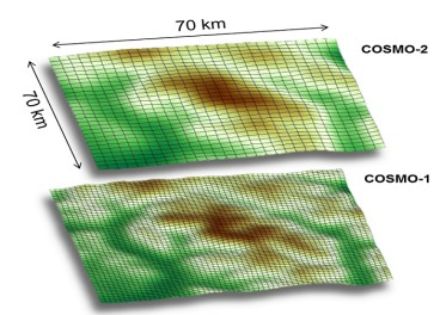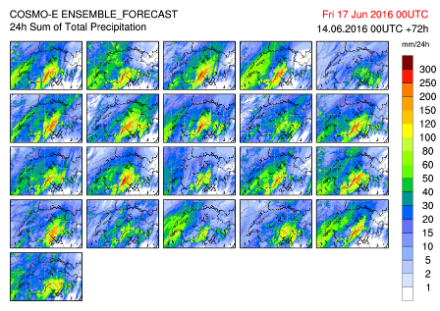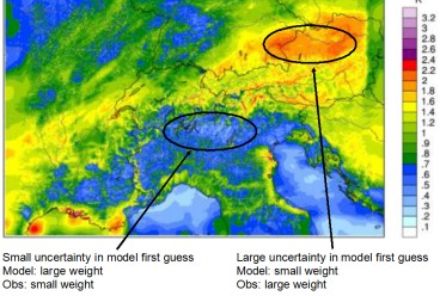Service Navigation
Search
The COSMO-NExT NWP system for the Alpine region incorporates
- the Local Ensemble Transform Kalman Filter (LETKF)-based ensemble data assimilation system,
- the deterministic COSMO-1, with a grid box size of 1.1 km, and
- the probabilistic COSMO-E, with a grid box size of 2.2 km.
COSMO-1 and COSMO-E have both become operational in spring 2016.
COSMO-1
Main properties:
- Deterministic forecasts with very high spatial resolution (1.1 km mesh-size) for the Alpine region
- Fast update cycle for short-range forecasts: seven times a day up to +33 hrs, at 03 UTC out to +45 hrs
- Initial conditions currently provided by a nudging assimilation cycle, will be replaced by an LETKF (see data assimilation)-based analysis
- Boundary conditions from ECMWF IFS-HRES forecasts
Output:
- Best available prediction of short-range evolution of the three-dimensional atmospheric conditions
Primary rationale for 1.1 km grid boxes:
- Better resolution of topography - important for surface weather in complex topography (see figure 1)
- Large-scale effects of deep convection converge at resolutions of O (1 km)
- Uncertainties avoided through parameterisation (e.g. convection scheme, SSO)
- Good compatibility with the resolution of many gridded datasets (e.g. radar, satellite)
Challenges:
- Stability of the dynamical core in the presence of steep orography
- Subgrid-scale modelling of turbulence

COSMO-E
- Main aims:
- Ensemble forecasting for the Alpine region which permits explicit convection modelling (2.2 km mesh-size)
- Forecasts twice a day up to + 120 hrs.
- 21 Ensemble members
- Initial condition perturbations from LETKF (see data assimilation)
- Boundary condition perturbations from ECMWF IFS-ENS
- Stochastically Perturbed Physics Tendencies (SPPT) used to simulate model uncertainties
Information on the forecast confidence as reflected by e.g., the consistency of the individual ensemble members (see figure 2) is a substantial added value of an ensemble forecasting system.

Data assimilation
Main aims:
- New ensemble data assimilation system based on the Local Ensemble Transform Kalman Filter (LETKF)
- Quasi-optimal and weather-dependent combination of observations and model predictions based on the relevant error statistic (see figure 3)
- Assimilation of observations not directly connected with the model variables, with input from observation operators
- Offers ensemble initial conditions for COSMO-E and deterministic initial conditions for COSMO-1
Which observations will be assimilated?
- Initially: conventional observations (TEMP, SYNOP, AMDAR, WINDPROFILER, SHIPS, BUOYS)
- Later: new remote sensing data, e.g. Mode-S data, RADAR volume data, data from ground-based remote sensing systems, GPS, satellite radiances
Output:
- Ensemble from 3-hourly analyses (probability density function)
- It thus provides not only the best guess (ensemble mean), but also the analysis uncertainty (ensemble standard deviation)

Infrastructure
Main aims:
- Operating requirements for COSMO-NExT
- COSMO-1: + 33 hr forecast in